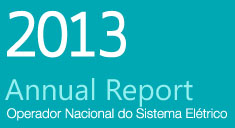Electric Operation
Medium Term Horizon
The planning process for the electric operation gives rise to two basic products: the Plan of Electric Operation in the Medium Term (PEL) and the Quarterly Guidelines for Electrical Operation Horizon (Quarterly).
The PEL 2013 presented the evaluations of the electrical performance of the BIPS for the period between the months of January 2014 to April 2015, while the Reporting Guidelines of Electric Operation details for each quarter of the current year, the necessary operative measures to meet the standards and criteria established in the Grid Procedures, in order to match the electrical constraints and the service to cargo with the energy policies, thus aiming at the lowest cost of operation and maximum operational safety of BIPS.
The studies evaluated the performance of regional interconnections, the connection of large blocks of generation and isolated system, the need for thermal generation due to transmission constraints and the attendance to electric fields of BIPS. As a result, the adequacy of the planned schedule of works to the needs of BIPS, with operational solutions and the change of the network topology has been proposed.
The PEL 2013 supported the identification of actions needed to ensure greater reliability for the host cities of the FIFA World Cup 2014: Sao Paulo, Brasilia, Belo Horizonte, Rio de Janeiro, Cuiabá, Manaus, Salvador, Recife, Natal, Fortaleza, Puerto Alegre and Curitiba. The need for additional thermal generation, energy constraints and adaptations and/or new Special Protection Systems (SEPs) was identified, so that the host cities maintain the supply in situations of simple loss and to ensure special performance even with double losses.
Actions were carried out to allow increased operational capabilities of both circuits of 440 kV TL Araraquara - Araraquara 2 and 500 kV Araraquara -Araraquara 2, aimed at minimizing the restrictions on the transfer of energy from the plants of the Madeira Complex by continuous current dipoles for the Southeast region, as there have been a delay to the start the operation of the receiver system planned for the flow of power from these plants.
The quarterly studies have focused on subsidizing the preparation of Instructions used in coordinating the operation of the BIPS. It also evaluated the performance of SEPs in operation, indicating the need for revision or deactivation of existing SEPs and installation of new ones. Such studies define the need for thermal generation by electric constraints as well as the limits of regional transmission interconnections and for the geoelectric areas.
On the 2013 studies, the search for alternatives to serve the western region of Pará, known as Tramoeste, and the power supply to Cuiabá are relevant. In both cases, short-term alternatives to provide greater security and reliability of the supply system to both regions, to the implementation of the respective structural solutions not yet been submitted to a bid.
In June 2013, the integration to the BIPS of the State of Amazonas was accomplished, with the implementation of the interconnection at 500 kV Tucuruı-Macapa-Manaus. In November 2013, the first dipole Porto Velho – Araraquara 2 became operational, permitting the flow from plants of the Madeira Complex for the Southeast region.
As for the aspects related to operational electrical safety, ONS has coordinated several actions together with the agents in order to diagnose the main weaknesses of the BIPS and indicate the steps to be taken to revitalize existing facilities, adapting them to safety standards established in the Grid Procedures.
The Facilities Modernization Plan (IMP) is prepared by the ONS with agents and in accordance with ANEEL Resolution No. 433/2011, features a collection of works necessary to maintain adequate service provision by transmission utilities. The Plan also lists the improvements and reinforcements that must be implemented by generators and distributors. The PMI drafted in 2013, covering the period between 2013 and 2016, recommends the deployment of 346 works of renovations, all to transmission companies.
Short Term Horizon
Throughout 2013, ONS developed studies and implemented contingency measures that made it possible to operate the grid in accordance with the criteria of continuity, reliability and quality of supply set out in the Grid Procedures, as outlined below:
- Analysis of about 40,000 interventions in BIPS, systemic safety has been ensured during the periods of these interventions.
- Implementation and monitoring of the performance of automatic reclosing of transmission BIPS lines schemes, to ensure continuity of service with increased reliability.
- Optimization of generating control systems to ensure adequate damping of electromecanical oscillations and to prevent loss of synchronization in the event of disturbances.
- Definition of Special Protection Systems, in order to ensure operational safety of BIPS, even in the event of multiple contingencies.
- Definition of new corridors of fluent recomposition of BIPS as well as updating the existing ones, to accelerate the normalization of supply disruptions afterwards.
Tests for integration of equipment associated with the transmission of Santo Antônio and Jirau plants system were performed. 17 generating units of the Madeira Complex were commissioned. On November 27, the commissioning of the converter stations of Porto Velho collector substation and substation Araraquara were completed, making them available for the operation.
In November, the testing of power equipment of the new supply point for the core network of the regions of Greater Goiânia, Annapolis and west of the state of Goiás, which consists of the provision of associated works at substation Trinity 500/230 kV -3x400 MVA were completed . The completion of these works sustains the growth of the market without the need for thermal generation plants in these regions.
At the end of 2013, new limits of reception to the northeast were established, aiming to ensure there is no risk of collapse in that region if the opening of the interconnections of the Northeast with the rest of the BIPS occurs.
